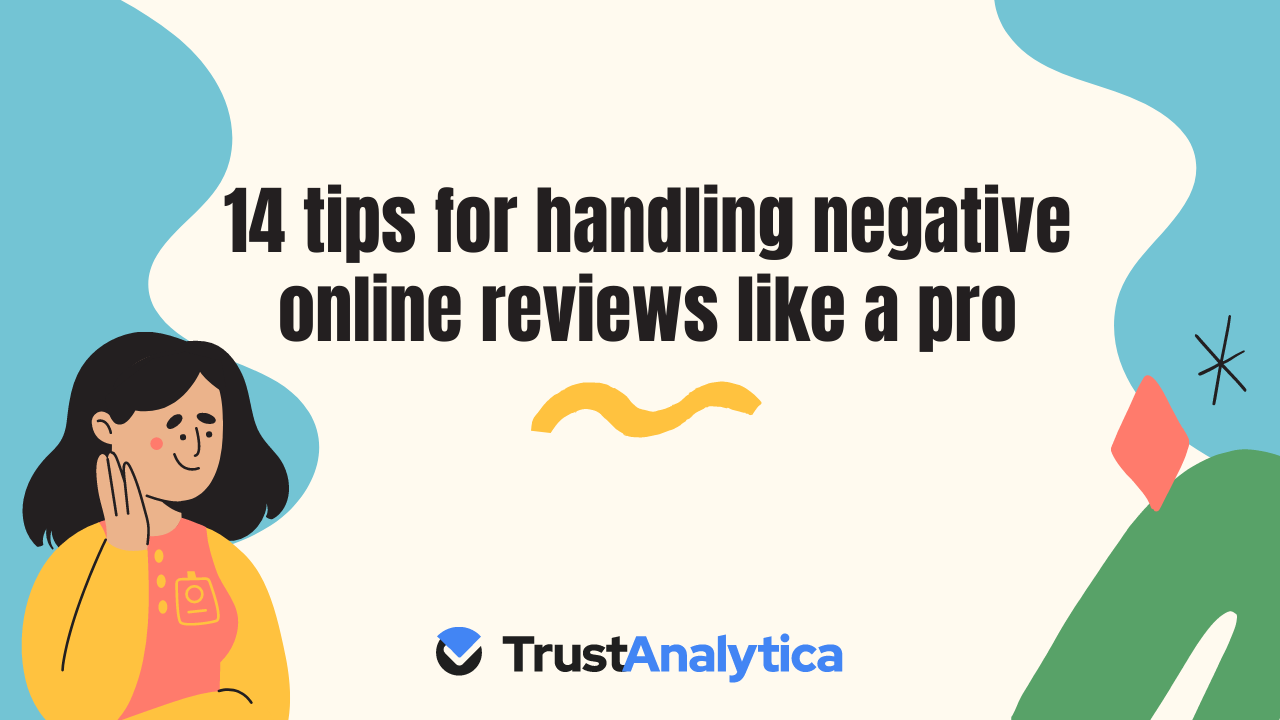Updated: 30th November, 2023 Complete bu*shi*, 1-star review, would not recommend “It was a complete waste of time and money. The service/product was terrible.” “The staff was not professional.” “I would not recommend this service or product to anyone.” “I’m never going to this place again.” These were bad customer reviews examples that can hurt […]

Updated: 30th November, 2023
Complete bu*shi*, 1-star review, would not recommend
“It was a complete waste of time and money. The service/product was terrible.”
“The staff was not professional.”
“I would not recommend this service or product to anyone.”
“I’m never going to this place again.”
These were bad customer reviews examples that can hurt your business:
While it’s never fun to be on the receiving end of criticism, there are some proactive steps you can take to compensate for the damage and turn a negative situation into a positive one.
First and foremost, don’t panic! A single negative review is not the end of the world, and how you handle it can make all the difference.
Negative online reviews can destroy the reputation of your business. Unfortunately, they can’t be avoided. You cannot please everyone, no matter what you do. You’ll inevitably receive a negative online review if you’re a business owner. The more important thing is how you deal with bad reviews and minimize the impact without losing too much credibility.
While it can be tempting to ignore them, negative reviews can provide valuable feedback. You can show that you are committed to providing excellent customer service by responding to negative reviews. Additionally, you can use negative reviews as an opportunity to upsell your product or service. By taking a positive approach to negative reviews, you can turn them into a valuable asset for your business

Here are some negative online reviews’ best practices
A single negative review can easily dissuade potential customers from using your products or services. However, there is a way to offset the negative impact of negative thoughts: by gathering positive reviews. Positive reviews can help to boost your business’s image and make it more likely that potential customers will choose to do business with you. In addition, positive reviews can help to drown out the negative reviews, making them less visible and less influential. As a result, if you’re worried about negative online reviews, gathering some positive ones from TrustAnalytica can effectively mitigate the damage.
If you receive a negative online review, responding promptly is essential. Don’t wait for days or even hours to address the study. Responding rapidly shows the reviewer that you take their concerns seriously and want to resolve the issue.
Nobody wants to see a bad review, but the best policy is always to be honest. If you can’t fix the problem, be upfront about it. Don’t make promises you can’t keep, and don’t try to push the issue under the rug. Tell the reviewer that you’re sorry, but you won’t be able to assist them. In addition, you can assure them that you will take care of the problem the next time so that they do not have to deal with the same problem.
Addressing complaints professionally and courteously is key to maintaining a positive reputation. It is essential to take the high road when responding to a negative review. Acknowledge the reviewer’s concerns and focus on trying to resolve the issue.
People who leave negative reviews often want to be heard. Showing that you’re receptive to feedback will go a long way in diffusing the situation. It may even prompt the reviewer to update their review or remove it altogether. Remember that your goal is to provide excellent customer service at the end of the day.
Negative online reviews can be stressful; the best practice is to take the communication offline as soon as possible. This way, you can avoid any further damage to your reputation and hopefully resolve the issue to the customer’s satisfaction. First, get the customer’s contact information to reach out to them directly. Then, ask for the best way and time to communicate so you can make sure they’re available and ready to talk.
When it comes to how to respond to negative online reviews, the most important thing is to stay calm and professional. It is tempting to lash out, but this will only worsen. Instead, take a deep breath and try to see the status from the customer’s point of view. Why are they unhappy? What can you do to resolve the issue? Once you’ve identified the problem, reach out to the customer and offer a solution.
Apologizing is one of the effective ways to deal with negative online reviews.
If your customer is unhappy with the product, the best thing you can do is apologize. Don’t try to justify yourself or make excuses. Just apologize and move on. Apologizing will show that you’re willing to accept your mistakes and commit to solving the issue. It will cost you nothing to admit that you were wrong, which could help diffuse the situation. In addition, responding to negative reviews shows potential customers that you care about your customers’ experience and are willing to satisfy them by going above and beyond.
Negative reviews are hazardous for small businesses, which can’t afford to have even a few unhappy customers. That’s why it’s so important to prevent negative reviews in the first place. The effective way to do this is to monitor the reviews regularly. By reading the reviews, you can address any negative comments quickly and resolve the issue before it becomes a bigger problem. In addition, by monitoring your reviews, you can get an idea of what areas customers are unhappy with and make changes accordingly.
One way to handle negative online reviews is if you can resolve the issue and satisfy the customer with how you addressed their concerns. You can then request the reviewer to edit or remove their negative review nicely.
When it comes to customer satisfaction, businesses need to go above and beyond to keep their clients happy. Companies can’t afford to lose valuable customers due to poor service or a faulty product. If a customer is not delighted with a purchase, you should take immediate action to rectify the situation. If the customer has suffered from financial loss, you can send him a replacement, offer a refund, or provide compensation.
If you get a negative review, the first step is to Thank the customer for their feedback and ask them what else we can improve in a product or service. This shows that you are willing to listen to feedback and improve, building customer trust and loyalty.
It’s easy to get offended when someone offers criticism, primarily if delivered less than kindly. However, it’s necessary to take a step back and see the situation from another person’s perspective. Sometimes, Negative reviews can be a good thing. They allow you to learn about what your customers don’t like and make changes accordingly.
Encouraging customers to leave reviews can help you avoid negative thoughts. You can get more positive ratings to balance out the negative ones by enabling customers to submit feedback. It can be done in a variety of ways. After payment, you can send follow-up emails or include a call-to-action on your invoice.
There are some situations when simply apologizing is not sufficient. Offering a credit that can be utilized at your store isn’t always the best option. Put an extra effort to demonstrate that you’re not only sorry but also that you want to fix the situation and regain the person’s trust. Sending an incentive could be the first step in the right direction.
A gift card or flowers could make a big impression. Sending a meaningful gift of gratitude and forgiveness could also help. Take the time to express that you care about your consumers and their experience with your company, no matter what you pick. It has the potential to change everything.

A single negative review can cause severe damage to a business’s reputation, and even a string of positive reviews may not be enough to counteract it. For this reason, companies need to understand how online review platforms and tools work and which ones are most popular with consumers. Only then can they effectively manage their online reputation and protect their business from negative reviews. Trust Analytica is one such tool that can help you deal with negative reviews.
A reputation management tool is of significant importance in the digital age where online presence and consumer perception greatly impact businesses.
Here are several reasons highlighting the importance of a reputation management tool:
Monitoring Online Reputation: A reputation management tool allows businesses to monitor their online reputation effectively. It tracks mentions, reviews, ratings, and social media comments across various platforms, providing real-time insights into customer sentiment.
Proactive Reputation Management: With a reputation management tool, businesses can proactively address negative feedback or issues before they escalate. It enables prompt responses, allowing businesses to resolve customer concerns, demonstrate accountability, and protect their brand reputation.
Enhancing Customer Satisfaction: By analyzing customer feedback through a reputation management tool, businesses gain valuable insights into their strengths and weaknesses. This information helps identify areas for improvement and enhance customer satisfaction, leading to increased loyalty and positive reviews.
Increasing Trust and Credibility: A reputation management tool assists in building trust and credibility by showcasing positive reviews and testimonials from satisfied customers. This social proof plays a crucial role in attracting new customers and influencing purchase decisions.
Improving Local SEO Rankings: Online reviews are a key factor in local search engine optimization (SEO). A reputation management tool helps businesses collect and manage reviews, which can positively impact their rankings on search engines like Google. Higher rankings lead to increased visibility and organic traffic.
Trust Analytica is a service designed to help businesses get more Google reviews, here are a few ways they might be able to assist:
Review monitoring: Trust Analytica can track and monitor your Google reviews, providing you with real-time notifications whenever a new review is posted. This allows you to respond promptly and engage with customers.
Review generation: Trust Analytica may offer tools or strategies to help you generate more reviews from your customers. This could include automated review request campaigns, customizable templates, or guidance on how to ask for reviews effectively.
Review analysis: Trust Analytica might provide sentiment analysis and insights on your existing reviews. By analyzing the sentiments expressed in the reviews, you can gain a better understanding of customer feedback and make informed business decisions.
Reputation management: Trust Analytica may offer reputation management services, helping you address negative or false reviews. They might provide guidance on how to respond professionally and resolve issues to maintain a positive online reputation.
Review marketing: Trust Analytica could assist in leveraging your positive reviews by creating marketing materials or social media campaigns that showcase customer testimonials. This can help build trust and attract new customers.
Handling negative online reviews like a pro can be tricky, but it’s definitely worth the effort. By responding to negative reviews and using them as an opportunity to improve your business, you’ll be able to show customers that you care about their satisfaction. This will help retain current customers, but it may also attract new ones.

